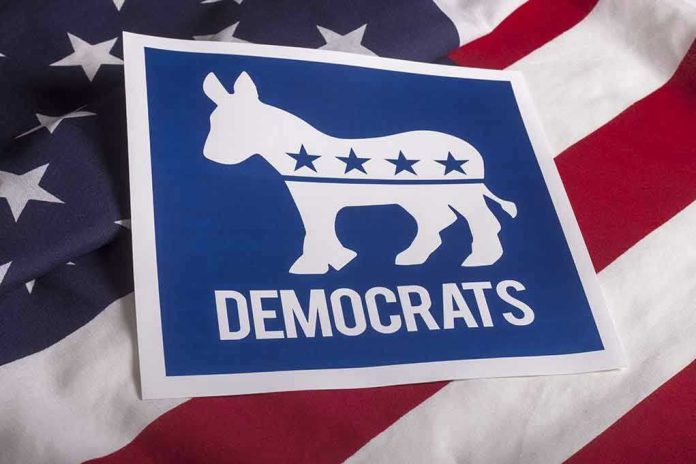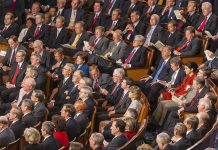
The Democratic Party’s oldest leaders are now locked in a high-stakes faceoff with a restless generation of firebrands, and neither side seems ready to blink—raising the possibility that age, not ideology, will be the force that reshapes the party’s future.
Story Snapshot
- President Biden’s withdrawal left a glaring leadership vacuum and intensified the generational divide within the Democratic Party.
- Younger challengers are mounting primary campaigns, targeting entrenched, senior incumbents in a push for new blood.
- Party elders are resisting change, issuing warnings to upstarts while polls and town halls show record-low approval among the base.
- The outcome will determine whether Democrats can evolve to meet new challenges or remain stuck in the past.
Younger Democrats Take On the Old Guard
Spring 2024 marked a turning point. As President Biden, age 81, bowed out of his re-election bid citing health concerns, the party’s succession crisis went public. The average age of Democratic House members—72—became more than a talking point; it symbolized a disconnect between leadership and the country’s rapidly changing political landscape. Younger Democrats seized the moment, launching primary campaigns against long-serving incumbents like Rep. Brad Sherman and Rep. Andre Carson. Their message was blunt: the party’s senior leaders had grown complacent and ineffective, unable to counter Republican advances with the urgency the times demand.
The generational insurgency is not just about policy disagreements or ideological purity. It is a stylistic and cultural revolt, driven by candidates like Jake Rak, Tuber Abugazale, Saikat Chakrabarti, and George Hornedo, who argue that the party needs fresh energy, sharper opposition tactics, and leaders who can speak to the concerns of younger voters. Grassroots support and social media amplify their campaigns, giving challengers a megaphone that rivals the institutional power of incumbents. The tension is palpable at town halls and in online forums, where party elders sometimes resort to veiled threats, warning upstarts to stay in line or risk alienating donors and power brokers.
Party Leadership Faces a Crisis of Identity
The leadership vacuum has exposed longstanding fissures within the Democratic Party. After a devastating loss in the 2024 election and the return of Donald Trump to the White House, Democrats find themselves searching for a new identity. The party base, especially younger and progressive voters, express deep dissatisfaction with the status quo. Senate Minority Leader Chuck Schumer and other senior figures urge unity and continuity, but their appeals increasingly fall flat. Consultant Rebecca Katz captured the mood: “Democrats are eager for leadership right now, and if their elected representatives fail to provide it, they will seek alternatives.” The warning is clear: resistance to generational change may come at the price of electoral irrelevance.
Incumbents rely on institutional resources, donor networks, and decades of experience to maintain their positions. Yet, as polls and town halls reveal, these assets may not outweigh growing frustration among voters who want action on pressing issues and a willingness to challenge Republican dominance. The party’s dilemma is not simply about age—it is about whether leaders can adapt to a rapidly shifting political landscape or risk being swept aside by a younger, more aggressive cohort.
Generational Conflict Redefines Party Dynamics
The current wave of primary challenges differs from previous insurgencies. Past efforts, like Alexandria Ocasio-Cortez’s 2018 campaign, were notable but isolated. Today’s movement is broader and explicitly focused on age and responsiveness. Multiple young candidates have declared their intent to take on senior incumbents across key districts, forcing the party to confront uncomfortable questions about succession, representation, and strategy. Social media fuels the conflict, with viral moments highlighting resistance from party elders and emboldening challengers. George Hornedo’s public account of being warned against challenging Rep. Carson underscores the party’s internal struggle.
Age Is the Issue That Democrats Can’t Shut Down https://t.co/7N72QxaA3G
— BixbyRme (@BixbyRme77407) November 11, 2025
The implications are profound. In the short term, Democrats face an unpredictable primary season, increased retirements, and heightened internal tensions. Long-term, the party may undergo a generational transformation, redefining its identity, priorities, and public image. Analysts argue that the outcome will shape not just the Democratic Party but the broader trajectory of American politics, influencing candidate recruitment, campaign strategies, and the fight against Republican policies. The risk of fragmentation is real, but so is the opportunity for renewal—if the party embraces the energy and ideas of its rising generation.
Expert Analysis and the Road Ahead
Democratic consultant Rebecca Katz and columnist Elwood Watson both agree: the age problem is undermining the party’s connection to younger voters and its ability to adapt. Academic analysts highlight the leadership vacuum and generational divide as central to the party’s current crisis. While some insiders warn that internal conflict could weaken the party’s ability to oppose Republicans effectively, others insist that renewal is necessary for long-term success. The consensus across credible sources is unmistakable—age and generational conflict are no longer issues the Democratic Party can ignore or suppress.
What happens next depends on the willingness of senior leaders to step aside, the resolve of younger challengers to persist, and the ability of the party’s base to demand change. As the election cycle unfolds, all eyes are on the outcome—will Democrats reinvent themselves or remain locked in a battle that neither side can truly win?
Sources:
Politico — Democrats age primary campaigns
My Journal Courier — Democrats still age problem
The Politic — The headless party inside the Democrats’ search for identity in the age of Trump









